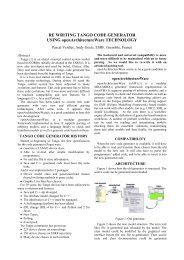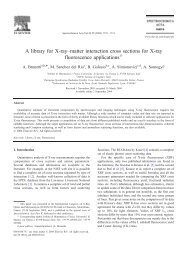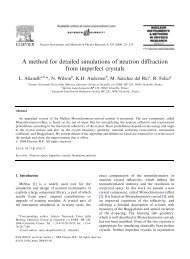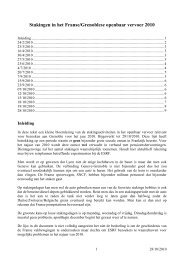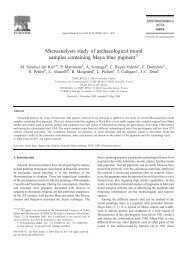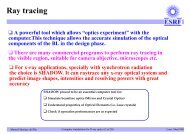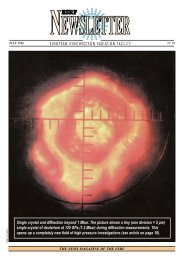Report on future detector requirements at ESRF
Report on future detector requirements at ESRF
Report on future detector requirements at ESRF
Create successful ePaper yourself
Turn your PDF publications into a flip-book with our unique Google optimized e-Paper software.
Flux <strong>on</strong> <strong>detector</strong>:<br />
The flux can reach 10 12 phot<strong>on</strong>s/s/pixel (with 100x100 µm 2 pixels) in few pixels and is much<br />
less in the other pixels: possibly 0.1 phot<strong>on</strong>/s/pixel.<br />
Particular oper<strong>at</strong>ing c<strong>on</strong>diti<strong>on</strong>s:<br />
The sample can be submitted to high pressure, high or low temper<strong>at</strong>ures, electric or magnetic<br />
fields but this should have no effect <strong>on</strong> the <strong>detector</strong> itself, except in the case of PMF, where<br />
the stray magnetic fields can reach 0.1 T. If the pixel size is smaller, the <strong>detector</strong> will be<br />
placed closer to the sample and will be more exposed to the stray fields.<br />
Intense diffracti<strong>on</strong> peaks can reach the <strong>detector</strong> either when carrying out single crystal<br />
diffracti<strong>on</strong> experiments or even in high pressure experiments due to the use of diam<strong>on</strong>d<br />
windows. Thus, the radi<strong>at</strong>i<strong>on</strong> damage risk should be estim<strong>at</strong>ed. Nevertheless, current<br />
<strong>detector</strong>s have never been significantly damaged by irradi<strong>at</strong>i<strong>on</strong>, probably due to the dose<br />
reducti<strong>on</strong> <strong>at</strong> high energy linked to the absorpti<strong>on</strong> drop.<br />
Required <strong>detector</strong><br />
The required <strong>detector</strong> is a large 2D <strong>detector</strong>, with good efficiency <strong>at</strong> high energy and<br />
improved readout time.<br />
Existing <strong>detector</strong>s<br />
ID06, ID09 and ID27 currently use Mar345 image pl<strong>at</strong>e, which fulfils quite well the needs<br />
c<strong>on</strong>sidering the existing available technologies. Main drawbacks are the very l<strong>on</strong>g readout<br />
time (2 minutes) as well as high background and vibr<strong>at</strong>i<strong>on</strong>s. ID27 also uses Mar165 CCD,<br />
which is faster but has still a l<strong>on</strong>g readout time (4 sec<strong>on</strong>ds), low sensitivity <strong>at</strong> high energy and<br />
small detecting area.<br />
ID11 uses FReLoN 2k and 4M cameras and would prefer to use a phot<strong>on</strong> counting <strong>detector</strong> in<br />
order to avoid correcti<strong>on</strong>s for the gain of the system, perform shutterless experiments and to<br />
have better dynamic range.<br />
ID15 uses a Pixium fl<strong>at</strong> panel, which appears noisier and slower than desired for their<br />
applic<strong>at</strong>i<strong>on</strong>s.<br />
Short term possibilities<br />
The Mar555 a-Se fl<strong>at</strong> panel would permit significant progresses in terms of size and<br />
efficiency. A Pil<strong>at</strong>us type <strong>detector</strong>, adapted to high energy with high Z sensor, could be<br />
promising. Medium term soluti<strong>on</strong> could also c<strong>on</strong>sist in tiling CCD sensors (such as Rigaku<br />
S<strong>at</strong>run A200 or Quantum 315) with high-Z screens.<br />
Main required improvements<br />
The main expected improvement c<strong>on</strong>cerns efficiency, where there is space to gain <strong>on</strong>e order<br />
of magnitude. Then, improvements <strong>on</strong> number of pixels, speed and noise are also desired.<br />
Integr<strong>at</strong>i<strong>on</strong> of the <strong>detector</strong> <strong>on</strong> the beamline (hardware and software…) is an important issue.<br />
Other types of <strong>detector</strong>s<br />
UPBL02 requires also other 2D <strong>detector</strong>s (see pages 30 and 71) and energy dispersive<br />
<strong>detector</strong> (see page 99).<br />
ID09HP, ID06LVP, ID15WB project requires also another 2D <strong>detector</strong> (see page 30) and<br />
energy dispersive <strong>detector</strong> (see page 99).<br />
M<strong>at</strong>Sci uses also a combin<strong>at</strong>i<strong>on</strong> of three 2D <strong>detector</strong>s in order to rec<strong>on</strong>struct an image of the<br />
structure of the sample (grains, strains…). This system combines two <strong>detector</strong>s, each <strong>on</strong>e<br />
46



